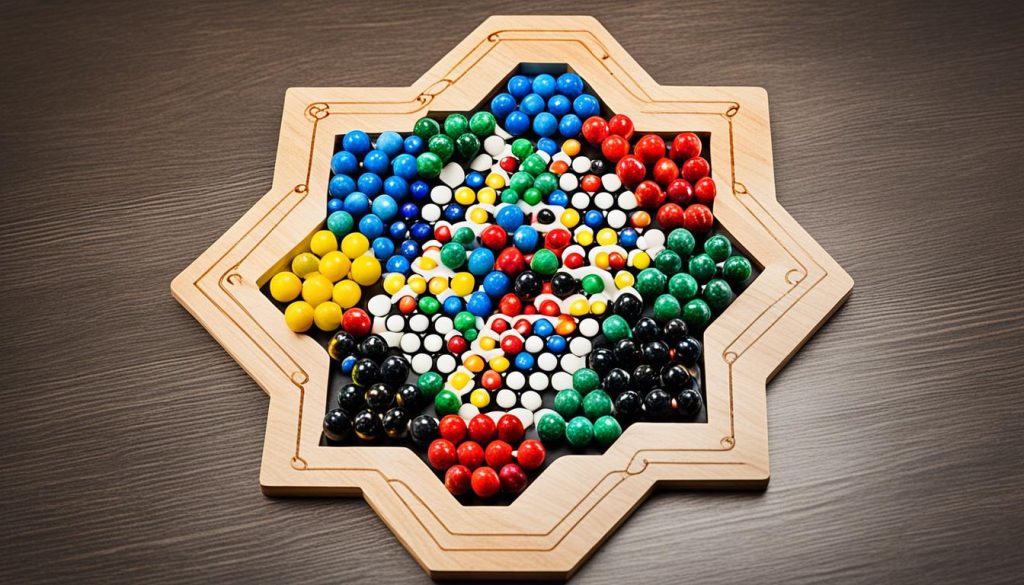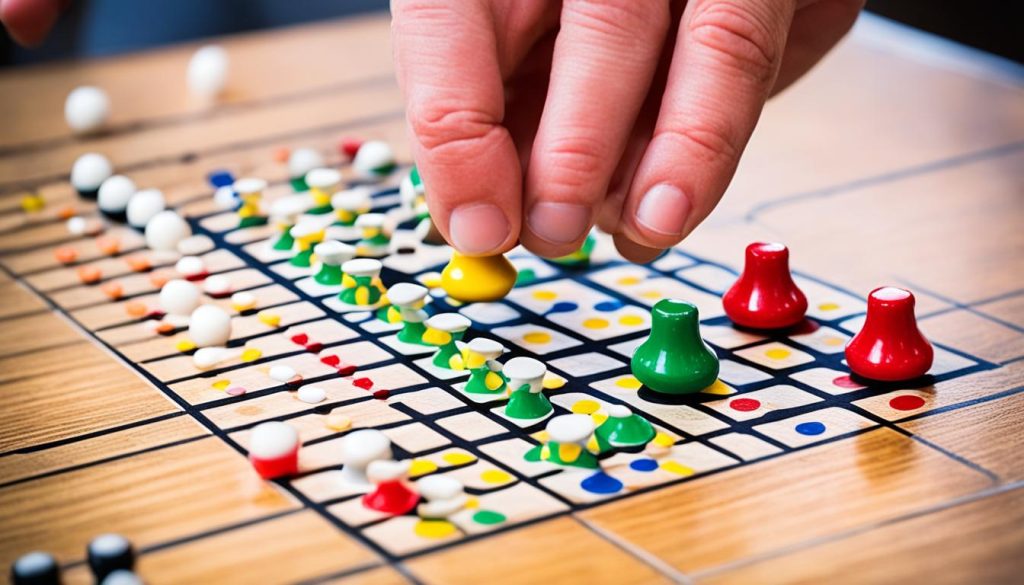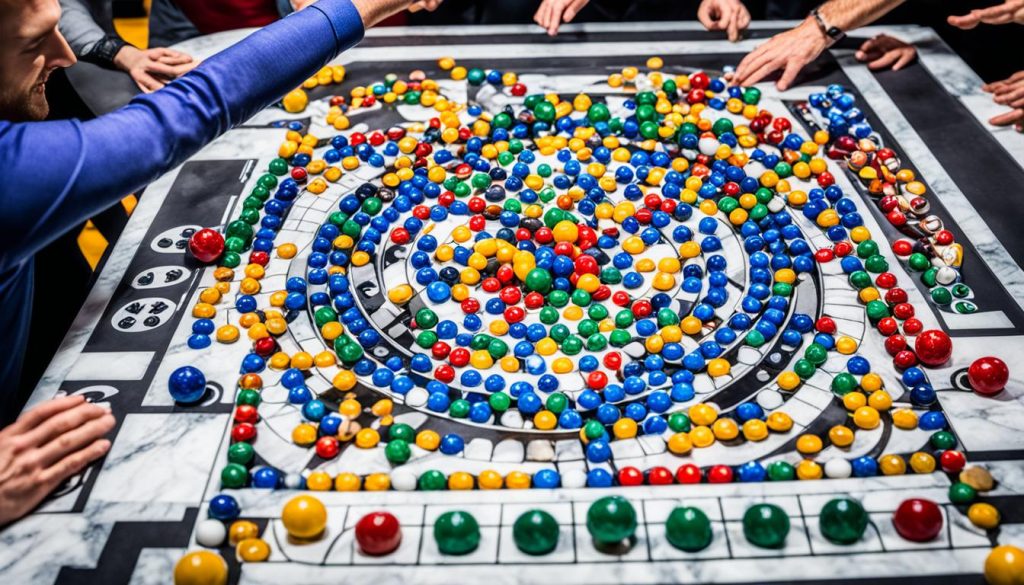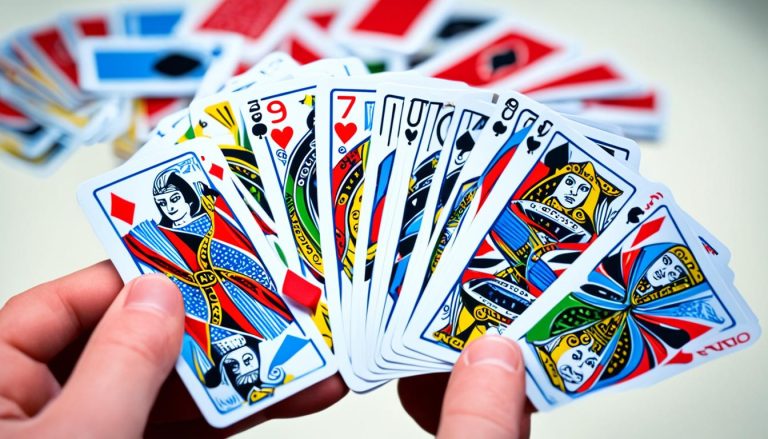Welcome to our comprehensive beginner’s guide on how to play Chinese Checkers. If you’re new to this classic board game or just need a refresher on the rules and strategies, you’ve come to the right place! Chinese Checkers is an exciting game that requires strategic thinking and planning. With step-by-step instructions and helpful tips, we’ll equip you with all the knowledge you need to play Chinese Checkers like a pro.
In this beginner’s guide, we’ll cover everything from understanding the game board to the object of the game and basic gameplay rules. We’ll also share winning strategies and tips to help you gain an edge over your opponents. By the end of this guide, you’ll be ready to enjoy the challenge and excitement of Chinese Checkers.
So, let’s dive in and discover the world of Chinese Checkers together!
Understanding the Game Board
In Chinese Checkers, the game board is shaped like a six-pointed star.
The board is divided into triangles, with each triangle containing 10 holes for the pegs. The number of triangles used in the game depends on the number of players:
- For 2 players, 1 pair of opposing triangles are used.
- For 3 players, every other triangle is used.
- For 4 players, 2 pairs of opposing triangles are used.
- For 6 players, all 6 triangles are used.
Each player places their pegs in the corresponding triangle on their side of the board.
| Number of Players | Triangles Used |
|---|---|
| 2 | 1 pair of opposing triangles |
| 3 | Every other triangle |
| 4 | 2 pairs of opposing triangles |
| 6 | All 6 triangles |
Object of the Game
The objective of Chinese Checkers is to emerge as the triumphant player by skillfully maneuvering all your pegs to the opposite triangle across the board. Unlike traditional checkers, the focus is not on capturing your opponent’s pieces, but rather on a strategic race to reach the opposite triangle before your opponents. The first player to successfully relocate all their pegs to the opposite triangle wins the game.
To illustrate the objective, imagine a dynamic battlefield where players must expertly navigate their pegs to the far side of the board. The opposite triangle serves as the ultimate destination, symbolizing victory and achievement. By skillfully planning your moves and anticipating your opponents’ strategies, you can outmaneuver them and secure victory, claiming the title of the winning Chinese Checkers player.
Quick Summary:
- The objective is to move all your pegs to the opposite triangle on the board.
- Victory is achieved by successfully relocating all your pegs before your opponents.
- Unlike playing traditional checkers, capturing opponent’s pieces is not the primary focus.
- The first player to reach the opposite triangle wins the game.

| Object of the Game |
|---|
| Move all your pegs to the opposite triangle on the board |
| The first player to complete this objective is declared the winner |
How to Play Chinese Checkers? – Gameplay and Rules
In Chinese Checkers, players take turns moving their pegs. Each turn, a player can move one peg to an adjacent space on the board. A peg can also hop over another peg, whether it’s their own or their opponent’s, as long as the hop is in a straight line and there are no “blocks” of 2 or more pegs in the way. Multiple hops are allowed in a single turn, as long as the hopping rules are followed.
Here are the basic gameplay rules of Chinese Checkers:
- Players take turns moving their pegs.
- Each turn, a player can move one peg.
- A peg can move to an adjacent space on the board.
- A peg can hop over another peg in a straight line.
- Hopping over an opponent’s peg is allowed.
- Hopping over multiple pegs in a single turn is allowed, as long as the hop is in a straight line and there are no “blocks” of 2 or more pegs in the way.
Moving your pegs strategically and utilizing the hopping ability is key to gaining an advantage in Chinese Checkers. By planning your moves and considering all possible hops, you can outmaneuver your opponents and make progress towards the opposite side of the board.

Example gameplay:
Let’s take a look at an example to better understand the basic gameplay rules of Chinese Checkers:
| Player | Move |
|---|---|
| Player 1 | Move peg from triangle A to adjacent triangle B. |
| Player 2 | Hop over Player 1’s peg and move from triangle D to triangle F. |
| Player 1 | Hop over Player 2’s peg and move from triangle B to triangle G. |
In this example, Player 1 moves their peg to an adjacent triangle, Player 2 then hops over Player 1’s peg to reach a different triangle, and finally, Player 1 makes another hop to progress further on the board. This sequence of moves demonstrates how pegs can be moved using the basic gameplay rules of Chinese Checkers.
What Are the Chinese Checkers Jumping Rules?
Chinese Checkers is a fun and strategic board game that involves moving your pieces across the board to reach the opposite corner. Here are the jumping rules for Chinese Checkers:
- A piece can jump over another of its own or an opponent’s piece that is adjacent to it, as long as there is an empty space on the other side.
- You can make multiple jumps in a single turn, as long as there are multiple valid jumps available.
- Jumping is not mandatory. You can choose whether or not to jump over a piece if it is strategically advantageous to do so.
- Pieces cannot jump over more than one piece in a single move unless there are multiple empty spaces beyond the pieces being jumped.
- If you reach the opposite corner of the board with all your pieces first, you win the game!
These rules add an extra layer of strategy and excitement to the game as you try to outmaneuver your opponents and race to the finish line. Enjoy playing Chinese Checkers!
Winning the Game
In Chinese Checkers, the victory condition is achieved when a player successfully moves all their pegs to the opposite triangle on the game board. This final triangle serves as the ultimate goal, and once a peg enters this triangle, it cannot be moved out for the remainder of the game.
The player who accomplishes this victory condition is declared the winner. It takes careful planning, strategic thinking, and calculated moves to ensure all pegs reach their destination. By considering different pathways, anticipating opponents’ actions, and making clever maneuvers, players can increase their chances of achieving victory.
As the game progresses, the competition intensifies, and players strategize to block each other’s progress and secure their own advantage. It’s essential to plan ahead, adapt to changing circumstances, and make decisive moves that maximize the potential for success.
To make the game even more exciting, there is an optional rule in Chinese Checkers that introduces a unique winning opportunity. A player can win by swapping their final peg with an obstructing piece in an opponent’s starting triangle. This rule allows for unexpected twists and turns, adding an extra layer of strategy and excitement to the game.
Remember, Chinese Checkers is not merely a race to the opposite triangle but a test of skill, foresight, and adaptability. Stay focused, employ smart tactics, and make precise moves to outmaneuver your opponents and claim victory.
Example Optional Rule
Swap Rule: In this optional rule, a player can exchange one of their pegs in the final triangle with an obstructing peg in an opponent’s starting triangle. This swap allows the player to clear their path for further movement and potentially block their opponent’s progress. To use this rule, all other pegs must be moved to the final triangle before engaging in a swap. The swap can only be done with a peg from the opponent’s starting triangle that is directly connected to the final triangle.
Example Scenario:
| Player 1 – Current Board | Player 2 – Current Board |
|---|---|
| Empty Final Triangle | Peg in Final Triangle |
| Peg in Starting Triangle | Peg in Starting Triangle |
In this scenario, Player 1 has successfully moved all their pegs to the final triangle, while Player 2 has one peg remaining outside the final triangle. As Player 1’s pegs are in the final triangle, they can initiate a swap. They choose to swap one of their pegs with the peg in Player 2’s starting triangle, effectively blocking further progress for Player 2 and increasing their chances of winning.

Variations of Chinese Checkers
Chinese Checkers, a beloved classic board game, has inspired various adaptations that introduce new elements and gameplay options. These variations offer unique twists and challenges, enhancing the gaming experience for players of all levels. Let’s explore some popular variations:
Super Chinese Checkers
“Super Chinese Checkers” takes the traditional gameplay to the next level by allowing unrestricted jumping and super jumps. Unlike the standard version, where pegs can only jump one space at a time, in Super Chinese Checkers, a peg can make larger jumps by leaping over multiple spaces in a single move. This adds an exciting dynamic to the game and requires players to think strategically about their moves.
Multiple Triangle Play
“Multiple Triangle Play” introduces the concept of controlling not just one triangle, but multiple triangles and sets of pegs. Players can strategically move their pegs across different triangles, utilizing their pieces to block opponents and create advantageous positions. This variation adds complexity to the game and tests players’ ability to multitask and manage multiple sets of pegs simultaneously.
Online and Mobile Versions
In today’s digital age, you can enjoy the thrill of Chinese Checkers anytime, anywhere with online and mobile versions of the game. These adaptations offer the convenience of playing on electronic devices and provide opportunities to compete against friends or players from around the world. Online and mobile versions of Chinese Checkers often feature interactive interfaces, customizable settings, and multiplayer options to enhance the gaming experience.
Whether you prefer the classic version of Chinese Checkers or enjoy exploring its exciting variations, there’s a version of the game that suits your preferences. From Super Chinese Checkers with its unrestricted jumping to Multiple Triangle Play and online/mobile versions, the world of Chinese Checkers offers something for everyone.
Strategies and Tips
To improve your chances of winning at Chinese Checkers, it’s important to employ strategic play. This can involve blocking opponents, anticipating moves, and planning your own moves in advance. Additionally, keeping your pegs together and not leaving any stragglers behind can help maintain control of the board and prevent your opponents from gaining an advantage.
Strategic play is the key to success in Chinese Checkers. By strategically positioning your pegs and anticipating the moves of your opponents, you can effectively block their progress and create opportunities for yourself. Here are some tips to enhance your strategic play:
- Control the center: Aim to occupy the central area of the board. This provides you with more options for movement and allows you to influence the flow of the game.
- Block opponents: Observe your opponents’ moves and strategically position your pegs to block their progress. By creating obstacles and limiting their options, you can slow them down and gain an advantage.
- Anticipate moves: Study the board and try to anticipate your opponents’ next moves. By predicting their actions, you can plan your own moves in advance and stay one step ahead.
- Maintain cohesion: Keep your pegs together and avoid leaving isolated pieces behind. This ensures that you have a strong presence on the board and makes it easier to execute coordinated moves.
Remember, Chinese Checkers is a game of strategy and planning. While luck may play a role, strategic play is the key to victory. By blocking opponents, anticipating moves, and staying one step ahead, you can tilt the odds in your favor and secure a winning position. Good luck!
Conclusion
In summary, Chinese Checkers is an exciting and stimulating game that demands strategic thinking and careful planning. By adhering to the rules and employing effective strategies, players can enhance their chances of victory. Whether you’re a novice or a seasoned player, Chinese Checkers provides an engaging and enjoyable experience for all. So gather your friends or family, set up the board, and get ready to immerse yourself in the world of Chinese Checkers!
With its unique board design and simple yet challenging gameplay, Chinese Checkers offers endless opportunities for strategic moves and exciting competition. Whether you’re aiming to outsmart your opponents or simply looking to unwind and have fun, Chinese Checkers has something to offer for everyone.
So what are you waiting for? Grab the pegs, plan your moves, and embark on a thrilling Chinese Checkers adventure. Enjoy the game, challenge your friends, and experience the joy of strategic play. Chinese Checkers is a classic game that never fails to entertain and captivate players of all ages. Get ready to dive into the world of Chinese Checkers and may the best strategist win!
FAQ
How to Play Chinese Checkers With 2 Players?
Playing Chinese Checkers with 2 players can be just as fun and challenging as with multiple players! To start, each player chooses a color and places their set of colored marbles in the opposite corner of the star-shaped board. The goal is to move all your marbles to the opposite corner by hopping over other marbles in a diagonal line. The first player to do so wins! However, if you want an added challenge, try playing with both sets of marbles and see who can get all their marbles to the opposite side first.
How to Play Chinese Checkers With 3 Players?
Chinese Checkers is a classic and strategic game that can be played with 2, 3, 4, or 6 players. If you have three players, the game is played in a triangular shape with each player starting on one of the points of the triangle. The objective of the game is to move all your pieces from your starting point to the opposite point on the triangle before your opponents do.
Can You Jump 2 in Chinese Checkers?
Absolutely! In fact, jumping multiple pieces in one move is a key strategy in Chinese Checkers. As long as there are empty spaces for your pieces to land on and you follow the diagonal motion of the game, you can jump as many pieces as you’d like in a single turn. So strategize wisely and outmaneuver your opponents with clever jumps!






